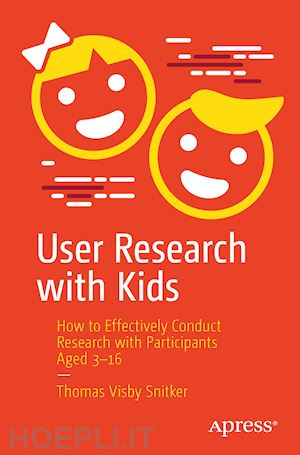

Questo prodotto usufruisce delle SPEDIZIONI GRATIS
selezionando l'opzione Corriere Veloce in fase di ordine.
Pagabile anche con Carta della cultura giovani e del merito, 18App Bonus Cultura e Carta del Docente
If you are a designer, producer, marketer, or researcher creating products for children, it is essential that you are aware of the key differences between children and adults when it comes to user journeys. While children might speak the same language as adult users, what they are actually communicating can be completely different. User Research with Kids explores these differences and more.
Author Thomas Visby Snitker walks you through how to best approach user research with children through the processes of conceptualization, design, prototyping, and eventually the launch. Adults who research kids’ experiences venture into a familiar yet foreign land where the inhabitants speak a different (yet familiar) language and have different behavioral norms and values. It is important for researchers to decipher and understand this language. Including children in the process will lead to better targeted and better designed products, and User Research with Kids will help you attain this goal.
Snitker’s useful insights in this book will help professionals and students in all sectors of research, design, and innovation. User Research with Kids will teach you how to better work with children using key approaches, such as understanding what play is and holistically measuring experience from a child’s cognitive perspective. Apply research rigor and best practices for your next product launch, and expand your user understanding with User Research with Kids.
Chapter 1: Understanding Kids and Their Experiences.- Chapter 2: How (Not) to Ruin Perfectly Good Research in 18 Steps.- Chapter 3: Succeed Through Better Research Practice.- Chapter 4: Towards Infinity and Beyond - A KX Score.- Chapter 5: What to Score.- Chapter 6: How You Can Use the Kids Experience (KX) Score.- Chapter 7: Challenges and Opportunities in Research with Children as Seen by Practitioners.- Chapter 8: Summary.-











Il sito utilizza cookie ed altri strumenti di tracciamento che raccolgono informazioni dal dispositivo dell’utente. Oltre ai cookie tecnici ed analitici aggregati, strettamente necessari per il funzionamento di questo sito web, previo consenso dell’utente possono essere installati cookie di profilazione e marketing e cookie dei social media. Cliccando su “Accetto tutti i cookie” saranno attivate tutte le categorie di cookie. Per accettare solo deterninate categorie di cookie, cliccare invece su “Impostazioni cookie”. Chiudendo il banner o continuando a navigare saranno installati solo cookie tecnici. Per maggiori dettagli, consultare la Cookie Policy.